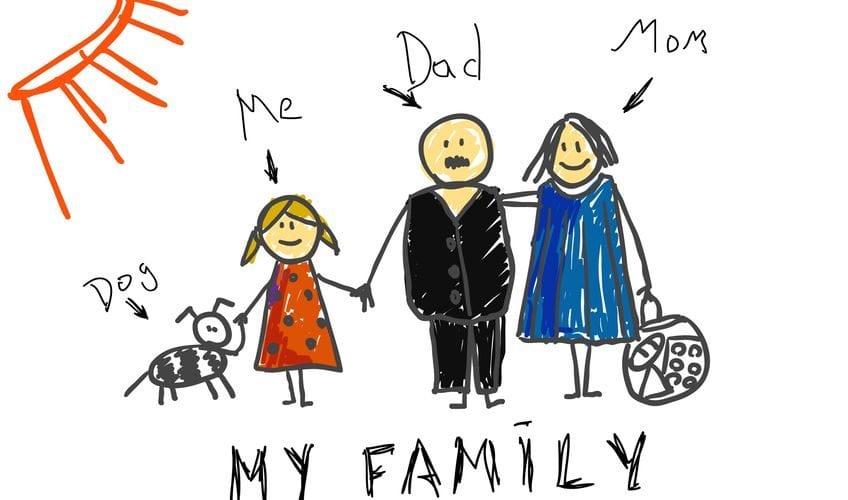Generation C: The Future of the Digital Family

One of the most remarkable transformations of our contemporary society can be seen in the way we inform and entertain ourselves through the web and social media. In the last twenty years, digital learning has made a deep impression on new generations, which they’ve harnessed with egocasting and infotainment. In a way, these trends meet basic needs.
The Egocasting Phenomenon
Over the past twenty years, the young generations Y and Z have grown up and evolved in the era of reality-based TV, video game, the new Web and social media technologies. A virtual world, where reality is often confused with fiction, and personal experience became the main source of gratification.
In the beginning of the new millennium, new popular platforms like MySpace, YouTube and Facebook emerged. These mediums have enabled diverse forms of self-expression and digital generations have quickly learned to use the new technological tools at their disposal to express and to show off. Through the status and profiles that they maintain on various platforms, individuals take the stage and becomes in some ways a new broadcast channel, a new source of content. Today it is through ¨selfies¨ and ¨shelfies¨ on Pinterest, Instagram and Snapchat that they seek their fifteen minutes of fame. (Read more Generation C: On Social Transformations center)
The Cult of Immediacy and Real-Time News
 Access to multiple sources of web-based and social media content has also created a culture of immediacy, which has seemingly long since supplanted conventional media and educational institutions as the main source of information and knowledge. Today, with new mobile technologies, users require instant answers to their questions and expectations. They prefer visual information, which is faster and easier to understand (i.e., videos, images and infographics). And they spontaneously choose popular platforms, such as Wikipedia, Google and YouTube for their research. Not surprisingly, they are accustomed to on-line retailers like eBay and Amazon for purchases.
Access to multiple sources of web-based and social media content has also created a culture of immediacy, which has seemingly long since supplanted conventional media and educational institutions as the main source of information and knowledge. Today, with new mobile technologies, users require instant answers to their questions and expectations. They prefer visual information, which is faster and easier to understand (i.e., videos, images and infographics). And they spontaneously choose popular platforms, such as Wikipedia, Google and YouTube for their research. Not surprisingly, they are accustomed to on-line retailers like eBay and Amazon for purchases.
At the same time, in the absence of mainstream institutions such as the established media and schools to guide them, the new generations were left to their own devices. They came to rely on their own judgment and intuition to separate the wheat from the chaff. Also, we can’t blame them for having adopted the path of simplicity. Today, with nearly 200 million blogs and over half of the planet being connected to the Internet and social media, discovering personally relevant information is like finding the proverbial needle in a haystack.
Digital family grow to the rhythm of the new generations
Over the past twenty years, family units (and communities) have also followed the path laid outby the digital natives. And, maybe it’s for the best that older generations have necessarily been driven by their offspring to new technologies; the parents of the new millennials (young baby boomers and older Generation X) have gradually adapted to these new paradigms. They have become ¨digital immigrants¨ and in turn adopted Information and Communications Technology (ICT) and the Internet, social media and mobile technologies, to stay connected to the new generations and the rest of the planet.
 At first, the gulf between digital learning levels amongst the generations was considerable, especially between boomers and young people of the new generation. From the start, reluctant to abandon their traditional methods, baby boomers were relatively reluctant to adopt hi-tech. During the first years of the millennium, this gap has been a major influence not only on families, but also on the whole economy. It has since forced social transformation of enterprises and organizations as the first cohorts Generation Y arrived on the labor market.
At first, the gulf between digital learning levels amongst the generations was considerable, especially between boomers and young people of the new generation. From the start, reluctant to abandon their traditional methods, baby boomers were relatively reluctant to adopt hi-tech. During the first years of the millennium, this gap has been a major influence not only on families, but also on the whole economy. It has since forced social transformation of enterprises and organizations as the first cohorts Generation Y arrived on the labor market.
By now, the oldest boomers have retired, replaced by leaders of Generation X. Consequently, work environments have already started to adapt to the new generations. Happily, however, over the years, the chasm between different generations has significantly reduced. New statistics recently released by the Pew Research Center’s Internet Project show that if social networks were the exclusive province of the new generations in the early years, much has changed since 2010.
After a dizzying growth of more than 80 percentage points posted between 2005 and 2010, web usage rate and social media by Generation Y has stabilized, reaching 90% in 2013. It’s with the baby boomer side (+ 12%) and seniors (+17%) that we see the strongest rate of increase in the use of Internet and social media since 2010 – a rate combined to nearly 30% over the past five years.
What can we expect from the Digital Family?
Today, with 65% of baby boomers, and 78% of users of Generation X now connected to the Web and social media, we can say that the clash of generations has definitely subsided. Actually, there are more and more households with three (and sometimes four) generations connected at the same time under one roof. The Digital Family has become a reality – a specific entity in which each member of the community is now using the same tools to communicate, inform and entertain. That means a lot!
Will this melding of connected generations have a positive influence on the future of social media? It remains to be seen. But the trend seems favorable and may be desired.
Do you agree? What do you think about the future of the new generations and the digital society? Do you think that together, we will find a way to build a better world for the future? Share your comments and points of view.
Image attribution: Copyright: ‘http://www.123rf.com/profile_tovovan‘ / 123RF Stock Photo
http://prblog.typepad.com/strategic_public_relation/2009/11/fort-hood-twitter-and-realtime-news.html
Raymond Morin
Latest posts by Raymond Morin (see all)
- The Growing Importance of Blockchain Technology - September 7, 2017
- From a Social and Solidarity Economy to a Sharing Economy - August 24, 2017
- The Changing Landscape of Social Media Usage - April 10, 2017

